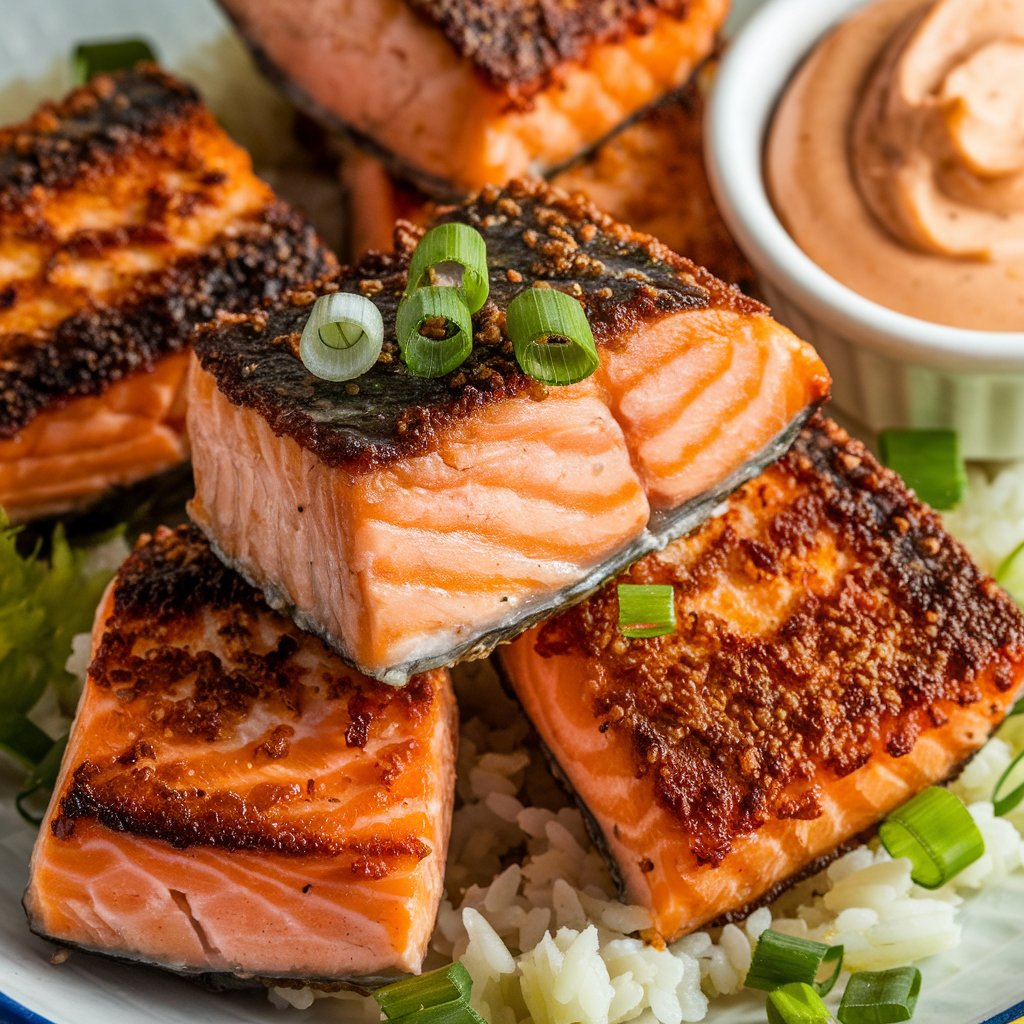I love the rich, buttery taste of salmon. But, cooking a whole fillet can be overwhelming, especially when time is tight. That’s why I adore salmon bites. They’re small, easy to make, and full of flavor.
In this article, I’ll share a simple salmon bites recipe that’s quick to make. These easy salmon canapes are perfect for parties, snacks, or when you want something new. Let’s learn how to make these seafood bites that will wow everyone.
Why Choose Salmon Bites?
Salmon bites are a tasty and healthy snack or appetizer. They are small but pack a big punch of flavor and health benefits. They’re perfect for any event.
Health Benefits of Salmon
Salmon is full of omega-3 fatty acids, great for your heart and brain. Eating omega-3 snacks like salmon bites keeps you healthy. They also have lots of protein, vitamins, and minerals, making them a healthy salmon recipe for everyone.
Versatile Dish for Any Occasion
Salmon bites are great for parties, quick appetizers, or main dishes. They’re small and easy to share. You can pair them with many dips and sides, pleasing everyone’s taste.
Salmon bites are a tasty and healthy choice for any event. They’re packed with health benefits and are easy to serve. It’s no wonder they’re a favorite omega-3 snack.
Ingredients You’ll Need
To make delicious salmon bites, picking the right ingredients is key. Whether you’re making smoked salmon finger food or tasty salmon appetizers, these essentials will make your dish stand out. They ensure your dish is full of flavor and will impress everyone.
Fresh Salmon Selection
Begin with top-quality, fresh salmon fillets. Choose salmon that’s bright in color and firm to the touch. Wild-caught salmon is best for its great taste and health benefits. Make sure to buy salmon that’s sustainably caught and looks and smells good.
Essential Spices and Seasonings
- Salt and pepper: These classic seasonings are a must-have, adding the perfect balance of savory and peppery notes to your salmon bites.
- Garlic powder: A sprinkle of garlic powder enhances the natural flavor of the salmon, creating a delightful aroma.
- Paprika: Smoked or sweet paprika can lend a touch of warmth and subtle smokiness to your salmon bites.
- Dill: Fresh or dried dill adds a refreshing, herbaceous flavor that pairs beautifully with salmon.
Optional Add-ins for Flavor
To enhance your salmon bites, consider these optional ingredients:
- Lemon zest: The bright, citrusy notes of lemon zest can elevate the overall flavor profile.
- Cayenne pepper: A pinch of cayenne pepper can add a subtle heat that complements the richness of the salmon.
- Chopped fresh herbs: Parsley, chives, or even a combination of herbs can provide a fresh, vibrant touch.
With these ingredients, you’re ready to make delicious smoked salmon finger food or salmon appetizers that will wow your guests.
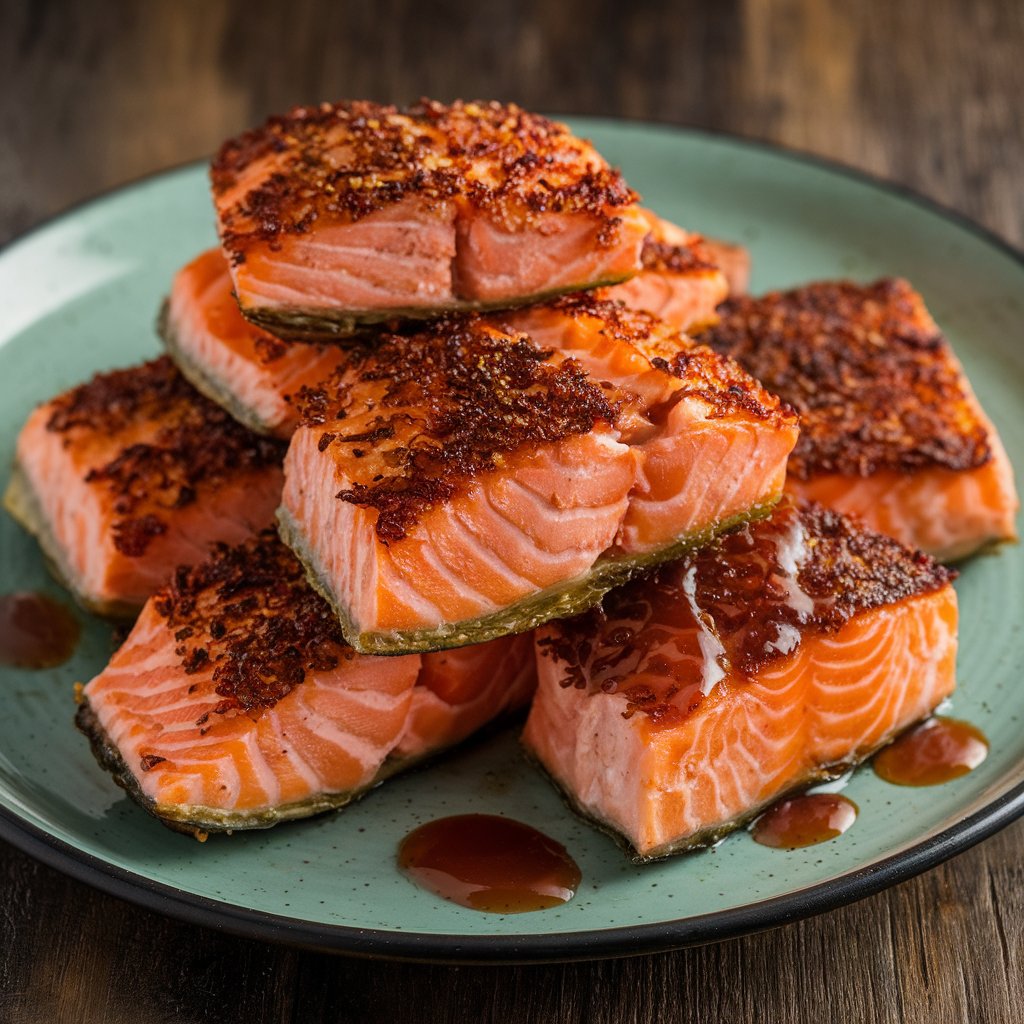
Preparing the Salmon
To make tasty salmon bites or seafood bites, start by preparing the salmon right. Make sure it’s skinned, deboned, and cut into small pieces. This is key for the right texture and taste in your dish.
Skinning and Deboning Tips
First, remove the skin from the salmon fillets. Use a sharp knife to slide it between the skin and the flesh. Start at one end and move down carefully to avoid wasting meat.
Then, look for any bones left in the salmon. Use tweezers or pliers to remove small bones. This makes your salmon bites smooth and enjoyable to eat.
Proper Cutting Techniques
After skinning and deboning, cut the salmon into small pieces. Try for cubes or rectangular shapes about 1-inch each. This size ensures even cooking and looks great in your dish.
For clean cuts, use a sharp chef’s knife and apply gentle pressure. Don’t saw back and forth, as it can make the edges rough. With a bit of practice, you’ll get good at cutting the salmon for your salmon bites or seafood bites.
Making the Batter
Creating the perfect batter is key for easy salmon canapes or salmon hors d’oeuvres. The batter gives a crispy coating that goes well with the tender salmon. Let’s look at what to consider when making the batter for your salmon bites.
Choosing the Right Flour
The flour you pick can change the texture and taste of your salmon bites. Here are some flour options to think about:
- All-purpose flour: A versatile choice that produces a light and crispy coating.
- Panko breadcrumbs: These Japanese-style breadcrumbs create an incredibly crunchy texture.
- Gluten-free flour: For those with dietary restrictions, gluten-free flour blends work well as a substitute.
Suggested Breading Alternatives
Want to try something different for your salmon hors d’oeuvres? Here are some tasty alternatives:
- Almond flour or coconut flour for a low-carb and gluten-free option.
- Crushed crackers or ground nuts for a unique and flavorful crust.
- Seasoned breadcrumbs for an extra boost of flavor.
Try out different flour and breading combinations. Find the perfect mix of crispiness and flavor that you like.
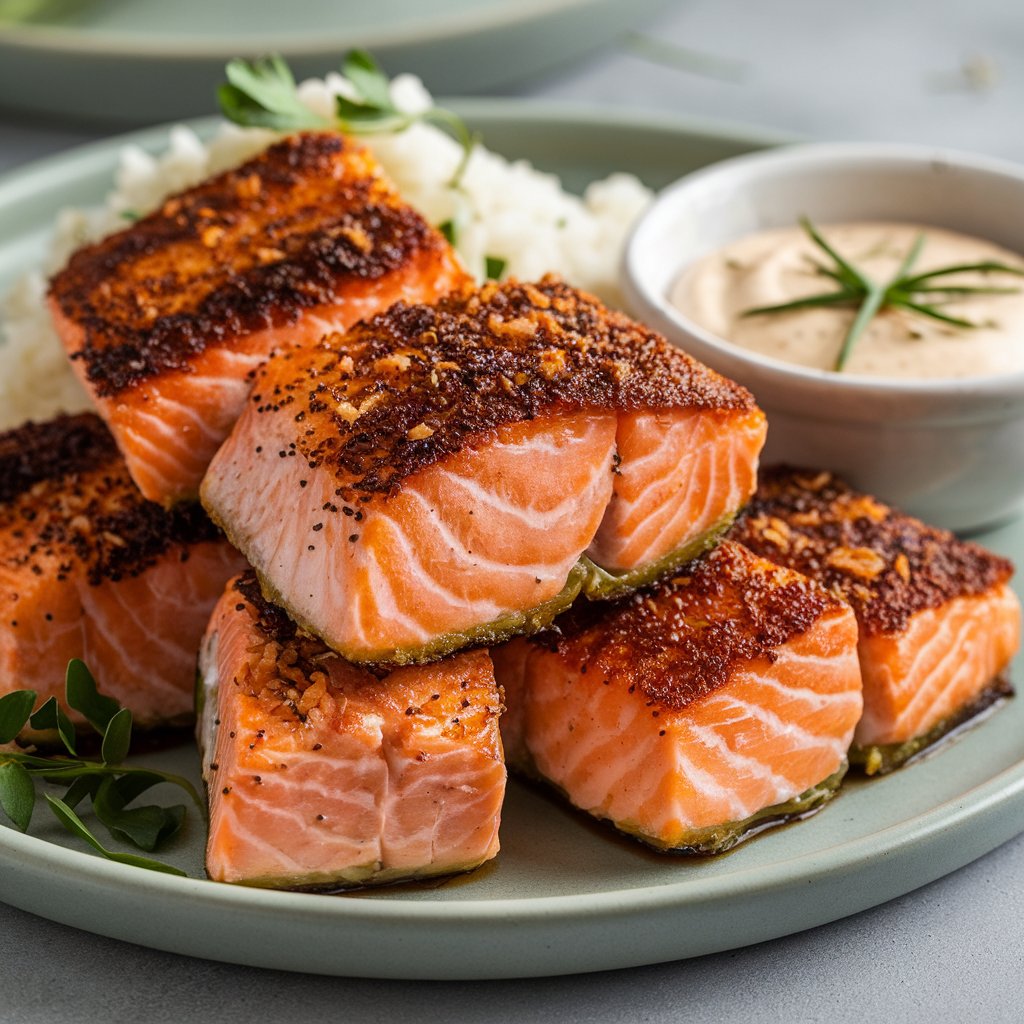
Cooking Methods for Salmon Bites
Choosing the right cooking method is key for tasty healthy salmon recipes like salmon bites. Let’s look at the good and bad of baking, frying, and grilling.
Baking vs. Frying
Baking is a healthier choice for salmon bites recipe. It uses dry heat to keep the salmon moist and flavorful. Plus, it uses less oil, which is good for your heart.
But, baked salmon bites might not be as crispy as fried ones. Frying, on the other hand, gives a crunchy outside and a juicy inside. It makes the salmon taste richer. Yet, frying uses more fat, so pick a healthy oil and watch the cooking time.
Grilling for Smoky Flavor
Grilling adds a smoky taste to healthy salmon recipes. It caramelizes the salmon’s sugars, making a tasty crust. Grilling also adds a char that goes well with the salmon’s flavor.
It’s important to not overcook the salmon bites recipe, as salmon can get dry. Stick to the recommended cooking times and temperatures. This way, you’ll get a crispy outside and a juicy inside.
Flavoring Your Salmon Bites
Make your salmon appetizers taste amazing by trying different marinades and spice blends. Salmon’s natural flavor is perfect for adding new tastes.
Marinades to Consider
Marinating your salmon bites before cooking adds extra flavor. Here are some marinades to try:
- Citrus marinade: Mix lemon or lime juice, olive oil, garlic, and herbs like dill or parsley.
- Teriyaki marinade: Use soy sauce, brown sugar, ginger, and sesame oil for an Asian twist.
- Honey-mustard marinade: Whisk together honey, Dijon mustard, apple cider vinegar, and a bit of cayenne pepper.
Spice Blends that Work Well
Enhance the taste of salmon appetizers with special spice blends. These mixes can make your smoked salmon finger food unforgettable:
- Cajun seasoning: Mix paprika, garlic powder, onion powder, cayenne, and dried herbs.
- Lemon-pepper: Use black pepper, lemon zest, and a pinch of salt.
- Chili-lime: Combine ground chili powder, lime zest, cumin, and a bit of brown sugar.
Try these marinades and spice blends to make your salmon bites delicious and unique. Be creative and find the perfect mix for your taste.
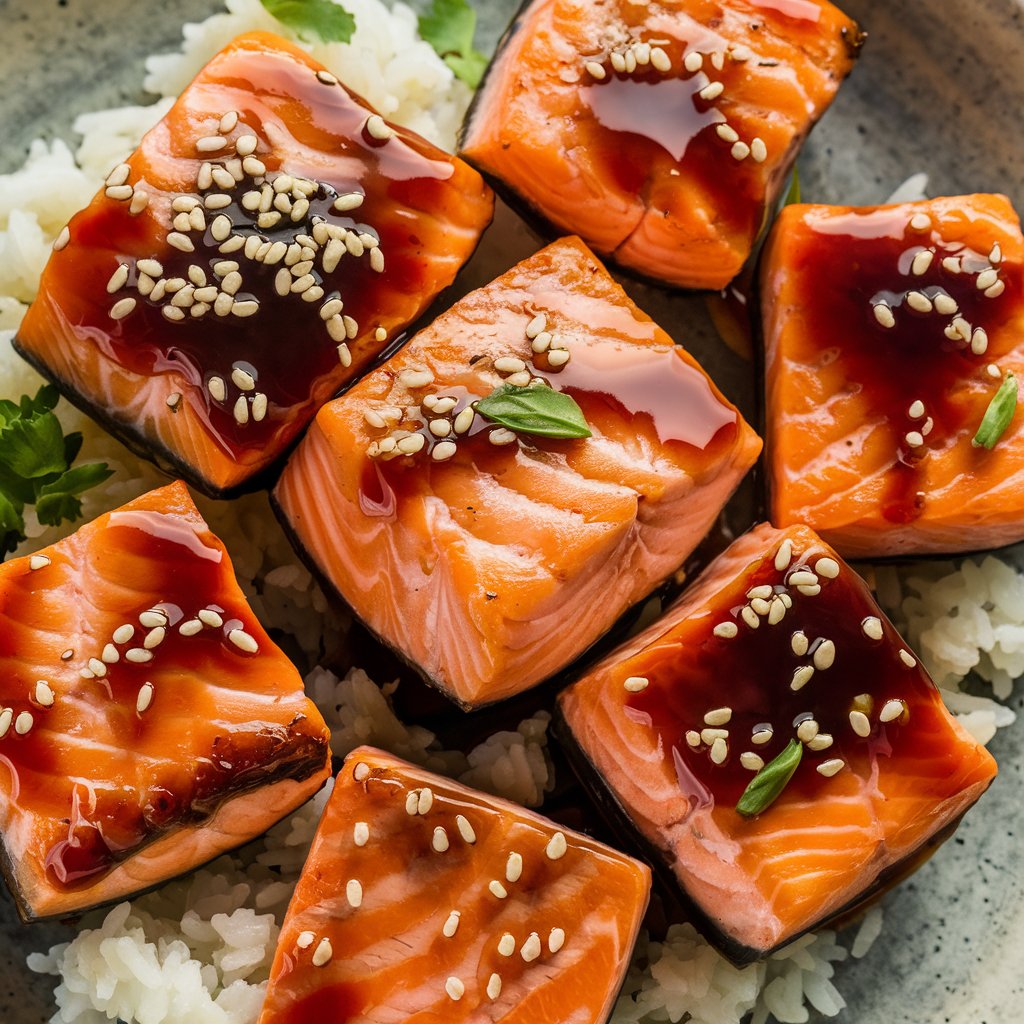
Serving Suggestions
When serving your salmon party snacks or salmon hors d’oeuvres, how you present them matters a lot. These small treats can make any event, big or small, even better.
Pairing with Dipping Sauces
For the best taste, try different dipping sauces with your salmon bites. A lemon-dill sauce or a zesty remoulade adds a nice tang. For a bit of spice, a creamy horseradish dip is great. Sweet options like honey-mustard or mango chutney are also tasty.
Complementary Side Dishes
- Try serving your salmon hors d’oeuvres with fresh veggie sticks like celery, carrots, or cucumber. They’re light and crunchy.
- For something more filling, pair the salmon party snacks with roasted or grilled asparagus, lemon-garlic green beans, or a colorful salad.
- Warm bread or flaky crackers are also great. They let you enjoy every bit of the salmon bites.
To make your salmon bites look good, use fancy platters, bamboo skewers, or mini dishes. Add fresh herbs, lemon wedges, or paprika for a fancy touch.
The secret to serving salmon party snacks or salmon hors d’oeuvres is balance and presentation. With the right sauces and sides, you’ll wow your guests with a fantastic meal.
Storing Leftovers
Enjoying delicious salmon bites doesn’t have to end when the meal is over. You can enjoy the leftovers for days with the right storage. Let’s look at how to keep your salmon bites fresh and tasty.
Best Practices for Refrigeration
To keep your salmon bites fresh and tasty, follow these easy steps:
- Store the bites in an airtight container or resealable plastic bag in the fridge.
- Try to eat the leftovers within 3-4 days for the best taste.
- Don’t leave the salmon bites at room temperature for more than 2 hours. This can cause bacteria to grow.
- If you want to freeze the leftovers, do it as soon as you can to keep them fresh.
Reheating Tips
When you’re ready to enjoy your salmon bites again, here’s how to make them crispy and tasty:
- Preheat your oven to 400°F (200°C).
- Put the salmon bites on a baking sheet lined with parchment paper.
- Reheat the bites for 5-7 minutes, flipping them halfway, until they’re hot and crispy.
- Don’t use the microwave, as it can make the bites soggy and lose their texture.
By following these simple steps for storing and reheating, you can enjoy your homemade salmon bites recipe for a long time. Enjoy your tasty seafood bites until the very last bite!
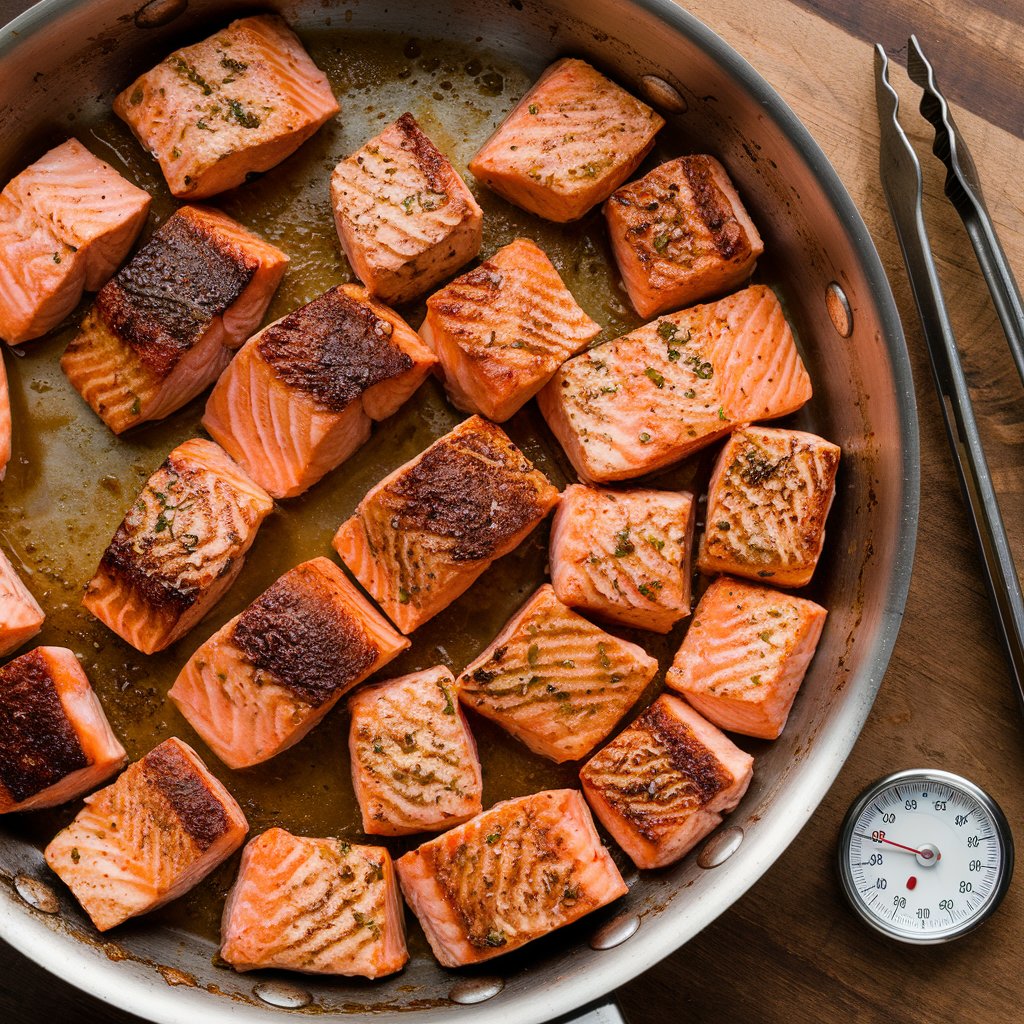
Salmon Bite Variations
Make your salmon bites more exciting with new twists and tasty additions! Discover easy salmon canapes and appetizers for all tastes.
Adding Cheese for Extra Creaminess
For a rich twist, add creamy cheeses to your salmon bites. Try mixing in grated cheddar, gouda, or cream cheese for a creamy taste. The cheese’s creaminess pairs well with the salmon’s flavor, making it a hit with guests.
Spicy Options for Heat Lovers
For those who love a little heat, try spicy salmon bites. Add cayenne pepper, chili powder, or diced jalapeños for a spicy kick. The bold flavors will delight those who love a bit of spice.
| Cheese Option | Spicy Option |
|---|---|
| Cheddar Cheese | Cayenne Pepper |
| Gouda Cheese | Chili Powder |
| Cream Cheese | Diced Jalapeños |
Try these variations to make a versatile and loved appetizer. Whether you choose creamy cheese or spicy flavors, your salmon bites will be a hit.
Perfecting Your Cooking Time
Getting the cooking time right for your salmon bites recipe is key. If you overcook, they can become dry and tough. On the other hand, undercooking makes them taste bad. Here are some tips to cook your salmon bites just right.
How to Avoid Overcooking
Watch the cooking time and temperature closely to avoid overcooking. Salmon bites cook fast, so keep an eye on them. Here are some tips to prevent overcooking:
- Use a meat thermometer to check the salmon bites’ internal temperature. It should be 145°F (63°C) for medium-doneness.
- Bake or fry the salmon bites at a high temperature (400°F/200°C) for a shorter time. This is better than a low temperature for longer.
- Don’t check on them too often. This can lower the oven or pan temperature and cause uneven cooking.
Tips for Ensuring Even Cooking
To cook salmon bites evenly, try these tips:
- Cut the salmon into uniform pieces so they cook at the same rate.
- Place the salmon bites in a single layer on your baking sheet or in your frying pan. Make sure there’s enough space for even heat.
- Flip the salmon bites halfway through cooking. This helps them brown and cook evenly on all sides.
By following these tips, you’ll get perfectly cooked, juicy, and tasty healthy salmon recipes every time.

Nutritional Information
Healthy omega-3 snacks like salmon bites are hard to beat. They taste great and are good for you. Let’s look at what makes these healthy salmon recipes so nutritious.
Calorie Breakdown
A serving of salmon bites, about 4-5 pieces, has 200-250 calories. Most of these calories are from protein and healthy fats in the salmon.
Macronutrients in Salmon Bites
- Protein: Salmon is packed with lean protein, giving you 20-25 grams per serving. This is great for muscles.
- Healthy Fats: Salmon is full of omega-3 fatty acids, like EPA and DHA. These fats are good for your heart and reduce inflammation.
- Carbohydrates: Salmon bites have very few carbs, making them good for low-carb diets.
Salmon bites also have important vitamins and minerals. These include vitamin B12, vitamin D, selenium, and phosphorus. They help keep you healthy and strong.
| Nutrient | Amount per Serving (4-5 pieces) |
|---|---|
| Calories | 220 kcal |
| Protein | 22 g |
| Total Fat | 14 g |
| Saturated Fat | 3 g |
| Carbohydrates | 3 g |
| Sodium | 370 mg |
Adding these omega-3 snacks to your diet is tasty and healthy. Enjoy making and eating homemade salmon bites. They’re part of a balanced diet.
Frequently Asked Questions
Starting your salmon bites recipe journey? You might have some questions. Let’s tackle some common ones to make your cooking a hit.
Common Mistakes to Avoid
One big mistake is overcooking the salmon. This makes it dry and tough. Keep an eye on the cooking time and temperature to keep it moist and flaky.
Also, be careful with your breading. You want it crispy but not soggy.
Substitutions You Can Make
Need to make changes to the recipe? No problem. If you’re gluten-free, use gluten-free flour or breadcrumbs. Vegetarians can swap in tofu or tempeh for a meatless option.

